Reviews
Review: Gran Turismo 5
January 24, 2011, Author: Giuseppe Nelva
Some say that the most difficult part of writing an article is the beginning. It’s often even harder to devise an inception for a review that would feel somewhat original and unique. In the case of Gran Turismo 5 such a task is actually quite trivial: all you need is to start without complaining about the relatively long development time, or the allegedly “endless” or “infinite” delays (for the record, the game has been delayed only twice, and one of those two times the delay was a mere twenty days, but looks like quite a few media sources somehow missed this detail).
Personally, I’m quite sure that Kazunori Yamauchi didn’t personally hold me at gunpoint to prevent me from playing any other game while I waited for Gran Turismo 5, so I would say that the fact that Polyphony Digital was allowed to take their time to work on the game is rather marginal and inconsequential to the end-user, if not actually positive.
Full disclosure: The reviewer played the game to level 31 A-spec and 37 B-spec, reaching a progress of 96% and driving 46,912 miles. He cleared all the special and seasonal events (to date) and all the license tests with gold and silver trophies. His garage includes 339 cars and he won 422 races, as tracked by his game profile, publicly accessible by looking up the PSN ID “Abriael”.
The “Real Driving Simulator” is finally true to its subtitle
Despite the “Real Driving Simulator” pay-off, the Gran Turismo series (mostly due to hardware limitations and market demand on consoles) has never truly been a simulation. Of course most of the cars featured a reasonable approximation of the handling of their real world counterpart, but GT games have always been quite far from the simulative fidelity (for the time) of PC titles like the Nascar Racing series or Grand Prix legends by Papyrus, and later the GTR series by Simbin.
That’s probably the main reason why I’ve never really been overly interested in the Gran Turismo titles from 1 to 4. While I had my share of fun with the shiny car porn and the sheer amount of information included, I’ve always been a bit disappointed by how arcade-ish the games felt.
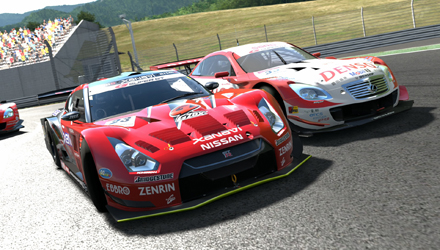
Two Super GT cars going head to head, beautifully.
With Gran Turismo 5 Polyphony Digital finally had the chance to work on a platform with the computational power necessary to release a full-fledged simulation, together with an audience mature enough to support that choice. That’s what gave me the hope to see the series steer radically towards realism, filling a rather big gap in the usually more arcade-oriented console market.
Accessing Gran Turismo 5 for the first time shows another radical change from the earlier chapters of the series. Now the whole experience has been built from the ground-up to accommodate online gameplay and interaction. Provided that a connection to the PSN is available, the game constantly accesses the internet in order to exchange information with the servers, allowing us to share cars, pictures and other bits of data with our connected friends. While this proved to be a double-edged sword during the first couple days after launch, with overcrowded servers effectively bogging the entire experience down to a crawl, the problems have long since been solved and everything works smoothly.
The interface itself has been target of harsh (even too harsh) criticism, due to the usual Japanese habit of creating slightly overly complex menus, but in the end everything is accessible and intuitive, and I had no problems while looking for any option I needed at any given time. It’s by no means the best interface I ever seen in a game, but it’s not even near the worst.
The main gameplay options are, as in the previous Gran Turismo chapters, GT Life (the career) and Arcade, that allows the player to run quick races using a selection of available cars, his favourites from his personal garage, or those imported from Gran Turismo for PSP. GT Life, though, is where the main areas of the game are located, prompting the player to create his racing persona (including the color of his racing suit and helmet that will be visible in-game) and to make it progress through several different events.
Even just by looking at the GT Life interface another radical divide becomes quite evident; the game is split between A-spec and B-spec. The first option will see the player taking the wheel himself to actually drive the cars and compete, while the second involves managing AI drivers through the events and races. A leveling system has also been introduced on the side of the usual credit-based monetary progression, keeping some events unavailable until the required level has been reached either in A-Spec or B-Spec (while credits are common, leveling is separated between the two). A-spec is obviously the core of GT5’s gameplay, and it involves several different kind of events: A-spec races, special events, seasonal events and licenses.
License tests have always been a classic staple of the Gran Turismo series, with players prompted to face several different short challenges that go from completing a section of a track in as little time as possible, to overtaking several cars in sequence, passing by the classic slalom between cones. Results will then be ranked Bronze, Silver or Gold, depending on performance. While bronze is relatively easy to achieve, gold is more often than not extremely challenging, and only the best drivers will manage to complete all the license tests to gold standards. Those that never loved the license tests will be happy to know that they’re not mandatory anymore (as they were in the previous instances of the series), letting the player chose exactly when (and if) to submit himself to some schooling and when to just go out and race.
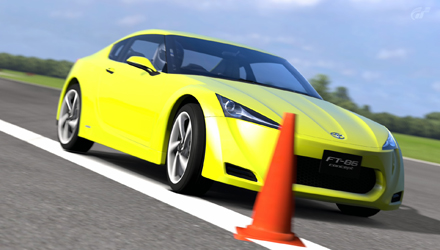
The infamous cone slalom license test will make some pull their hair out.
While I welcomed this change myself, since it’s always great to be given the choice, my personal advice is not to neglect the licenses. They aren’t the most fun activity available in GT5, but their educational value is very high, even for accomplished and experienced drivers. Each test is designed to school budding virtual drivers in techniques that they will find very useful both online and offline, and getting at least a silver in all of them will improve a player’s ability very visibly. Just to bring an example, I personally always had trouble finding the right window of opportunity to overtake in previous racing simulators, often missing the chance completely because my lack of proper training led me to approach the problem too conservatively. After completing all the overtaking challenges in the GT5 license tests, the problem disappeared almost magically, giving me the ability to properly “see” an opening and exploit it correctly to overtake cleanly both during straights and corners.
A-Spec events are the classic core of Gran Turismo, with 54 racing series that go from the easy Sunday Cup, progressing in difficulty and challenge up to the physically taxing endurance races, culminating with the 24 hours of Le Mans and of the Nurburgring. All of the series are either made of one or more separate races that can be played in any order, or full-fledged championships that require coming on top in a point-based ranking board to win.
While there’s a wide variety of races and events to take part in, there are a few evident flaws, like the complete absence of specific events for some of the cars included in the game (Rally and Formula 1 ones, for instance) and the inability to save during Endurance races. This is a personal pet-peeve of mine, considering that I hate leaving any console on overnight (especially taking in account the fact that this generation of consoles isn’t exactly the sturdiest), determining a factual impossibility to complete the longest races, unless you’re willing to risk the very possible case of fatal overheating.
Hopefully Polyphony Digital will realize that not everyone can afford driving for twenty-four hours in a row (not even real drivers do, since in real endurance events multiple drivers alternate at the wheel), and will soon implement the option to save one’s progress during the longest events. Special events are very possibly my favourite aspect of the whole game. They include eight special challenges that focus on a very specific aspect of racing, from Karting to Nascar, and prove both a welcome change of pace from the usual racing and a very challenging environment to improve one’s skills. Karting is especially fun, and has been a very welcome surprise to basically everyone I talked to. With their snappy response and great sense of speed due to the lowered position near to the asphalt, kart races keep the player on his toes all the time, proving a great addition to the GT5 line-up.
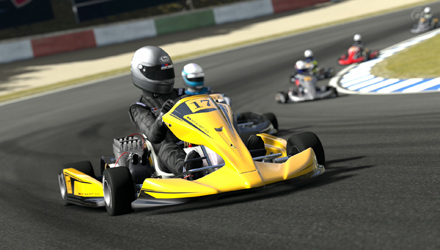
Karting is fun offline, and it's FUN online. F-U-N.
The AMG Driving Academy is another of my personal favorites, featuring the queen of all racing tracks; the Nurburgring. Grabbing a hard-earned gold trophy in this difficult challenge involves learning the track in its slightest detail. Considering how complex and challenging the Nurburgring is, getting to the point of really knowing it is an extremely rewarding and powerful experience for anyone interested in simulated driving. This said, I’d be hard pressed to find even one of the special events that I wouldn’t define as a lot of fun and a rewarding, challenging and educational experience in its own right.
The final area of A-spec includes the Seasonal Events, a series of challenges refreshed overtime (new ones are introduced weekly and are available for a couple weeks afterward). They are split in Bonus Races, Time Trials and Drift Trials. Bonus Races involve several cars/track combinations, and see the player starting last in the grid, having to climb to first position in an allocated number of laps. Time Trials and Drift Trials involve competing with other players in an online leaderboard over the best lap time or best drifting performance on a given course.
This kind of event is a very welcome addition to the GT5 line-up, providing more variation to the A-spec races and “forcing” the player to explore cars that he might have overlooked before, while the time trials and drift trials involve the player in a wider online competition, offering a level of challenge that’s normally appreciated by the most hardcore and competitive racers between our midst. Seasonal events are also another step in the direction spelled by Kazunori Yamauchi, that sees Gran Turismo 5 more as a ever-evolving and fresh MMORPG experience than as a static “packaged game” experience, that ends up becoming stale after a few weeks/months. If the influx of new seasonal events will remain weekly like it’s been so far, we can easily say that the transition has been completed successfully.
B-spec can be defined a sideshow to A-spec, but it’s arguably a quite beefy one. Here the player moves away from the role of driver, and takes on that of team manager, creating and leading a team of AI drivers from the early level of amateur-hood, to the glory of professional racing. All the events available in A-spec are present in this mode as well (excluding special and seasonal events), providing a nice variety of challenges. Each AI driver will have a rank that defines his overall ability, and several stats that will evolve during his career, like in a RPG, improving his performance. The gameplay itself is rather simple, with the AI-driver “performing” in a replay-like race, and the player giving him simple instructions like “raise pace”, “lower pace”, and so forth, keeping track of physical and mental fatigue and (later in endurance races) pit stops.
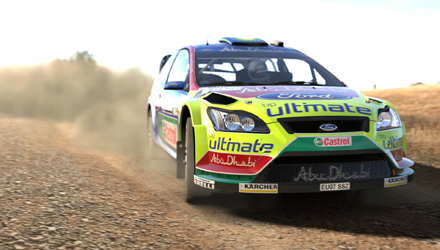
Driving Rally cars is challenging and spectacular. Too bad for the lack of Rally A-spec races besides the special events.
As a gameplay mode in itself, B-spec is a bit shallow and not overly fun. It becomes, though, a very interesting option if seen in, what I consider, the right light. As players of a racing simulator, we’re obviously supposed to be at the wheel ourselves when our other engagements allow, so yeah, just standing in front of the monitor and seeing our B-spec drivers crunch lap after lap won’t be very fun. It’ll be little more interactive than watching a race on TV, without the comment.
On the other hand, there are many times in our day in which we cannot really sit in front of our favourite game, giving it all the attention that would be necessary to compete ourselves. During those times in which we’re either working or doing some other activity, we can still divert our attention a bit to the PS3 in order to give some sparse commands, though, and that’s when B-spec comes into play. In the end it’s an extremely effective way to keep our GT5 time productive (allowing us to gain more credits that we can then spend in the game) even when we’re not really playing the game, acting as an effective mitigation to any need of grinding in order to purchase the most expensive cars. In the meanwhile, we’ll have a really nice looking screensaver running on our TV; everyone wins.
Add to it the function that’s going to be added in February, and that will allow us to access B-spec through a computer browser, and it will turn our GT5 experience into a truly full-time one. A dedicated Gt5 player will be able to drive when he has time to, to let his B-spec drivers drive for him when he doesn’t, and to access through the browser even when he’s not at home. I’ll let you decide if this would have a positive or negative effect on your life, but we have to admit that it’s a rather effective and clever way to accommodate the needs of a player-base with extremely different habits and schedules. To complete the picture, GT Life allows us to access the dealerships where we can buy new cars, a Tuning Shop to “soup them up” and the GT Auto shop, that lets us perform several minor but vital tasks.
Thanks to the Tuning Shop we can add several tuning parts to our car, allowing us to customize it to our heart’s content, with more powerful engines, better suspensions or transmission kits and so forth. The shop offers a nice variation of parts, allowing us to put our greasy fingers into basically every area of a car. The only two glaring omissions are the absence of any after-market brakes (partly offset by the ability to customize the brake bias on every car from the get-go), and the inability to customize the ratios of every single gear of the shift. Even the fully customizable transmission only allows the tuning of the final gear, which is a bit of a perplexing design choice (that will be corrected soon, according to Yamauchi).
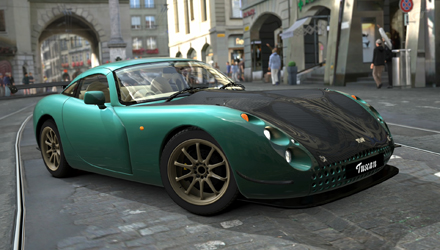
Carbon Fiber hoods are fully modeled, and include the appropriate pins.
A beautiful little detail is the (at long last!) correct visual implementation of carbon fiber hoods, something that I always found rather jarring in other racing simulators. You can chose to have the carbon hood painted in the same color of the car or “naked” (showing the carbon fiber itself, with a rather spectacular effect). On top of that polyphony went as far as modeling the hood pins that are normally used to keep the bonnet in place. Talk about attention to detail. On the other hand the GT Auto shop allows for some tasks that are absent in basically every other racing simulator, like performing an oil change, a complete rebuilding of the engine and the restoration of the rigidity of a car’s body. It’s also possible to change the rims of the cars with lighter ones, to install various aero parts like spoilers and skirts and to paint the body/rims in a different color.
Pages: 1 2 3 4Platforms: PS3 | Tagged Gran Turismo 5, GT5, Kazunori Yamauchi, playstation 3, Poliphony Digital, PS3, Racing Simulator, review, Sony, wall of text



